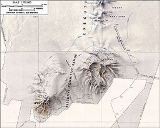
Mount Waesche
Encyclopedia
Mount Waesche is a large and prominent mountain
of volcanic origin, standing immediately SW of Mount Sidley
and marking the southern end of the Executive Committee Range
in Marie Byrd Land
. The feature is snow covered except for rock exposures on the south and southwestern slopes. The volcano may have been active as late as the Holocene
(last 10,000 years), and may be only presently dormant.
Discovered by the United States Antarctic Service expedition on a flight, December 15, 1940, and named for V. Admiral Russell R. Waesche, United States Coast Guard, member of the Antarctic Service Executive Committee.
Mountain
Image:Himalaya_annotated.jpg|thumb|right|The Himalayan mountain range with Mount Everestrect 58 14 160 49 Chomo Lonzorect 200 28 335 52 Makalurect 378 24 566 45 Mount Everestrect 188 581 920 656 Tibetan Plateaurect 250 406 340 427 Rong River...
of volcanic origin, standing immediately SW of Mount Sidley
Mount Sidley
Mount Sidley is the highest volcano in Antarctica, a member of the Volcanic Seven Summits, with a summit elevation of . It is a massive, mainly snow-covered shield volcano which is the highest and most imposing of the five extinct volcanic mountains that comprise the Executive Committee Range of...
and marking the southern end of the Executive Committee Range
Executive Committee Range
The Executive Committee Range is a range consisting of five major mountains, volcanic in origin, which trends north-south for along the 126th meridian west, in Marie Byrd Land, Antarctica....
in Marie Byrd Land
Marie Byrd Land
Marie Byrd Land is the portion of West Antarctica lying east of the Ross Ice Shelf and the Ross Sea and south of the Pacific Ocean, extending eastward approximately to a line between the head of the Ross Ice Shelf and Eights Coast. It stretches between 158°W and 103°24'W...
. The feature is snow covered except for rock exposures on the south and southwestern slopes. The volcano may have been active as late as the Holocene
Holocene
The Holocene is a geological epoch which began at the end of the Pleistocene and continues to the present. The Holocene is part of the Quaternary period. Its name comes from the Greek words and , meaning "entirely recent"...
(last 10,000 years), and may be only presently dormant.
Discovered by the United States Antarctic Service expedition on a flight, December 15, 1940, and named for V. Admiral Russell R. Waesche, United States Coast Guard, member of the Antarctic Service Executive Committee.

